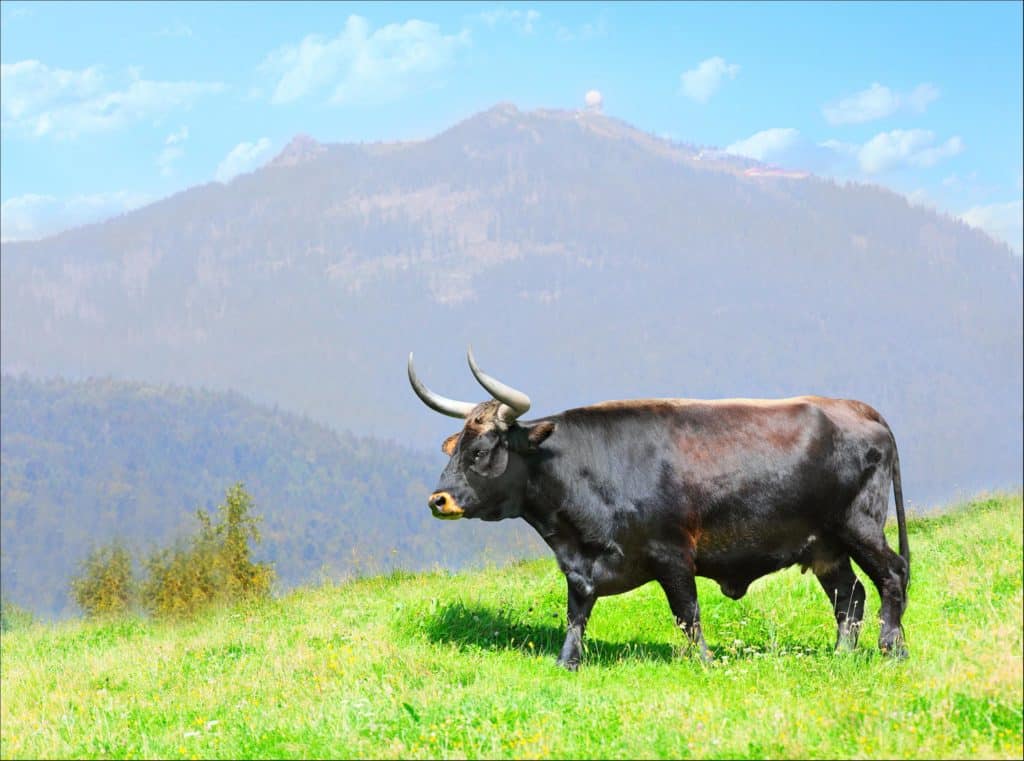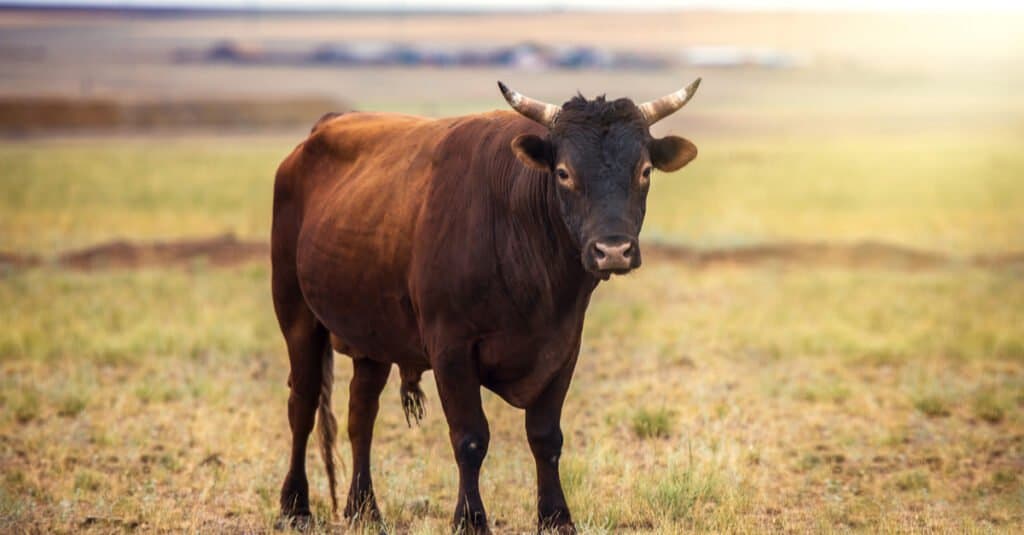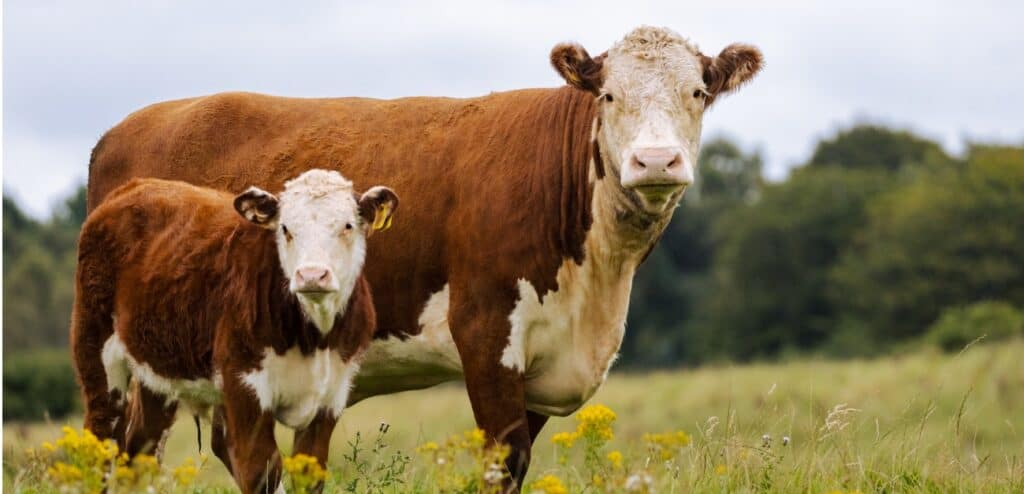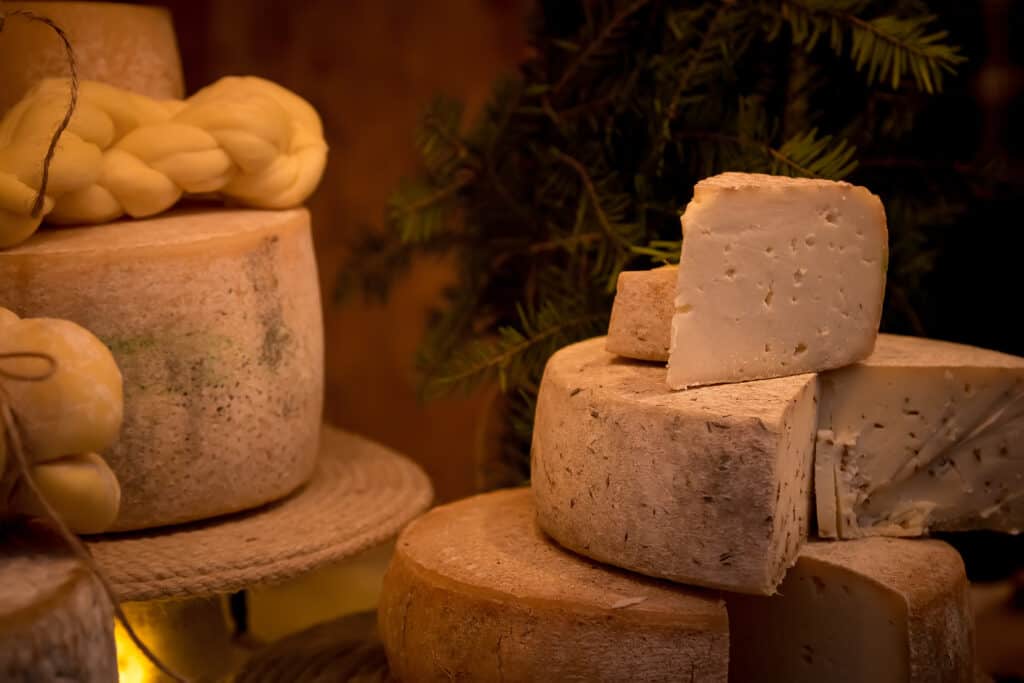Domesticated cattle are one of the most prevalent animals across the entire earth, but many people don’t know much about their history! The history of domesticated cattle is long, but it can all be traced back to one ancient species: the auroch. Although the auroch is extinct, its legacy still lives on. Today, we will explore the differences and similarities between the Auroch vs Cow and see what makes them special. Let’s get started!
Comparing an auroch and a cow

| Auroch | Domesticated cow | |
|---|---|---|
| Evolutionary history | Extinct species of cattle that were the wild ancestor of modern domesticated cattle. A member of the Pleistocene megafauna that died out in 1627. | Domesticated descendants of the auroch, roughly 10,500 years ago. |
| Size | Height: 60-70 inches at the shoulder Weight: 1,540-3,310 lbs | Can vary drastically across various breeds. Height: 62-69 inches at the shoulder Weight: 600-2,500 lbs. |
| Appearance | Longer, more slender legs when compared to a cow. Significantly longer skull and horns. More athletically built. Born chestnut color and turned black as they aged. | Varies drastically according to breed. Large, four-legged hooved mammals. Coat can be long or short and can come in almost any color. |
| Distribution | North Africa, Mesopotamia, Europe, India. | Worldwide. |
| Relationship with humans | Wild aurochs were hunted and used for food, clothing, and tools. Eventually domesticated during the Neolithic Revolution in the Fertile Crescent. | One of the most important domesticated animals in the world. |
| Related species | All modern cattle descended from the auroch. Three distinct subspecies. | Over 1,000 breeds of cattle are recognized globally. |
The 5 main differences between an auroch and a cow
The main difference between an auroch and a cow is that aurochs are extinct and the ancient ancestors of a cow, while modern cattle have spread all over the world and are extremely prevalent.
Aurochs are some of the most important animals in the history of humans, despite having gone extinct a few hundred years ago. The reason? Aurochs are actually the ancient ancestors of every major breed of domesticated cattle in the world! Whether the cows we raise for meat or dairy cows that make milk and cheese products, humanity can thank the ancient auroch for those items.
The first aurochs evolved around 200,000 years ago during the Holstein interglacial period. These large creatures were members of the Bovini family and were related to bison, gaur, yaks, and the African buffalo. As these animals spread, either starting in Africa or India, they would eventually be encountered by humans. Ancient humans relied on the wild auroch as a food source before eventually domesticating them during the Neolithic revolution. Once the wild auroch was domesticated, the first cows came only a short time later as humans selected for certain traits.
As their genetic similarities suggest, the auroch and cow are extremely similar in a few ways. In appearance and size, aurochs are a bit larger and more slender than most modern breeds of cow. Additionally, they were almost always black with a white stripe, whereas cattle could be almost any shade.
The wild auroch had a distribution that began in either North Africa or India and eventually spread to Europe and Asia. Domesticated cattle originated in the Middle East but are now present in nearly every human civilization on the planet.
Let’s look at some of these differences in more detail below!
Auroch vs Cow: Evolutionary history

The ancient auroch likely evolved a quarter of a million years ago, while cows came around 10,500 years ago.
©Kletr/Shutterstock.com
Near the Holstein interglacial, the auroch first appeared on the fossil record around 230,000 years ago. They are members of the Bovini tribe, making them related to the Zebu, European and American bison, yaks, African buffalos, and more. The wild auroch went extinct in 1627 when the last individual in Poland was killed.
The modern cow can trace its ancestry back to the wild auroch. Domestication of the auroch began during the Neolithic Revolution nearly 10,500 years ago. Scientists believe that all cattle can trace their roots to a group of 80 aurochs domesticated in the Fertile Crescent region thousands of years ago.
Auroch vs Cow: Size

Aurochs were probably larger than the average cattle breed.
©Berezovaya Nonna/Shutterstock.com
The wild auroch grew smaller as human presence pushed them closer and closer to extinction, but the ancient groups were probably larger than most modern-day cattle. On average, wild aurochs measured 60-70 inches at the shoulder and weighed 1,540-3,310 lbs.
Exact cattle sizes depend on breeds, but most cows are 62-69 inches at the shoulder and weigh 600-2,500 lbs.
Auroch vs Cow: Appearance

Aurochs were born chestnut colored and matured into a dark black color. Cows can come in all sorts of coat types and colors.
©Simon Vasut/Shutterstock.com
The wild auroch looked bovine in appearance, although it had longer legs and a more muscular and athletic build. Additionally, it was born a chestnut color and turned dark black with a white eel stripe down its back.
The modern cow is extremely variable in its appearance due to the number of breeds. They can come in any hair length or coat color and have various body types and sizes.
Auroch vs Cow: Distribution

Aurochs historically lived across Europe, Asia, Africa, and India, and cows are found nearly everywhere on the planet.
©iStock.com/Scott Allan
The wild auroch originated in North Africa or India and spread into Europe and Asia.
Domesticated cattle can be found nearly anywhere humans live today.
Auroch vs Cow: Relationship with humans

Aurochs and cows have been important resources for humans for thousands of years, particularly in meat and dairy products.
©Rudinski Vyacheslav/Shutterstock.com
The wild auroch was hunted as a source of meat and fur. Additionally, they had cultural significance and were later domesticated during the Neolithic Revolution.
The modern cow is the source of all beef products and most dairy products worldwide. Additionally, domesticated cattle are used as a beast of burden and are widely culturally significant.
Auroch vs Cow: Related species
Auroch subspecies:
- The Eurasian aurochs (B. p. primigenius) were part of the Pleistocene megafauna in Eurasia.
- The Indian aurochs (B. p. namadicus) lived on the Indian subcontinent.
- The North African aurochs (B. p. mauritanicus) lived north of the Sahara.
There are over 1,000 breeds of modern domesticated cattle.
The photo featured at the top of this post is © Annabell Gsoedl/Shutterstock.com
Thank you for reading! Have some feedback for us? Contact the AZ Animals editorial team.






